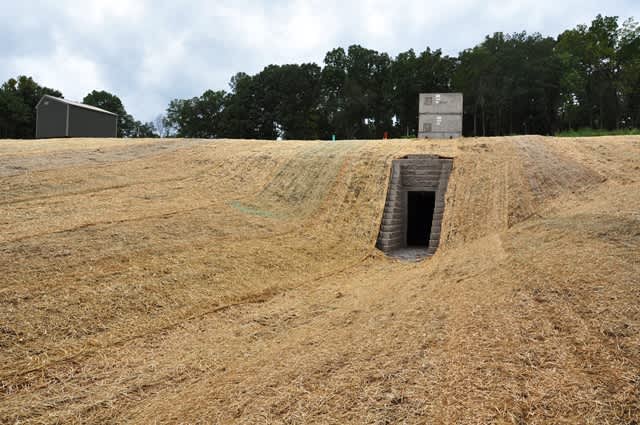Tennessee Artificial Bat Cave to be Safe Haven from White-nose Syndrome
OutdoorHub Reporters 09.24.12

A man-made cave that is to serve as a winter hibernation site for bats is being built in Tennessee outside of Clarksville. This is a one-of-a-kind project meant to be a safe haven for bats from white-nose syndrome, which is believed to have killed approximately six million bats in the United States since its presence was first discovered in North American bats in 2006.
This is the first bat cave of its kind. It’s a highly-experimental cave since there is no guarantee that bats will actually populate it come winter. There are two other artificial bat caves in Texas, but they serve as summer roosting sites, not as a hibernaculum.
Nature Conservancy Communications Manager Paul Kingsbury is optimistic the bats will come. He said the Conservancy has consulted leading bat experts, including those from the U.S. Fish and Wildlife Service, who feel that this will work. With the use of bats calls, the Conservancy hopes to attract bats into the climate-controlled cave.

It’s not guaranteed that white-nose syndrome won’t enter the cave, but if bats can survive the winter with the syndrome, they will heal through the summer. When the bats leave in warmer months, the Conservancy plans to sanitize the cave to rid it of any Geomyces destructans, the fungus that causes white-nose syndrome. Such sanitation is not possible in real caves since it would wipe out the entire ecosystem present in the cave – all the insects, amphibians, fish and other harmless fungi that live there.
Kingsbury said the Conservancy is racing to finish the cave by the time bats begin seeking a hibernation location in early to mid-October. Read the press release below to find out more about its construction, controlled habitat and the agricultural importance of bats.
Original press release issued by The Nature Conservancy on August 29, 2012:
To combat an epidemic that is decimating bat populations across eastern America, The Nature Conservancy in Tennessee is building an artificial bat cave.

The Nature Conservancy began building the artificial cave on August 23, 2012, in Montgomery County, Tennessee, near an existing bat hibernation cave. The real cave is located on property that The Nature Conservancy bought in 2006. The cave and surrounding land is now owned and managed by the Tennessee Wildlife Resources Agency. Construction on the artificial cave is expected to be complete by the end of September 2012 to allow bats to take up residence.
White-nose syndrome (WNS) is the disease the Conservancy is fighting. Since its February 2006 discovery in a cave in upstate New York, WNS has spread to 19 states and 4 Canadian provinces and killed more than 5 million bats. In many caves where WNS has appeared, bat colonies have been reduced by 90 percent or more.
WNS was first detected and confirmed in Tennessee in February 2010. WNS is caused by an invasive fungus known as Geomyces destructans that was not documented in American caves prior to 2006. There is no cure yet, and WNS threatens to render many U.S. bat species extinct.
The loss of millions of bats could have enormous implications for people. Bats are highly beneficial to agriculture. They act as pest-control by eating many of the insects that damage crops. Studies have estimated the value of bats to Tennessee agriculture at $313 million annually and the value to the nation’s agriculture at $3.7 billion. Tennessee is a critical home to bats; in fact, there are more caves in Tennessee (nearly 10,000) than in any other state.
“WNS is a devastating disease that is hitting bats fast and hard,” said Cory Holliday, Cave and Karst Program Director for The Nature Conservancy in Tennessee. “This artificial cave not only has the potential to save a large colony of bats from WNS, but also to serve as a model that could be replicated anywhere WNS threatens to destroy a significant colony of hibernating bats.”
The new structure—the first man-made hibernation cave for bats—is underground and will mimic the cold, damp environment of the nearby natural cave. The artificial cave will be a safe haven for bats to hibernate in during winter. It will also serve as a test site for WNS treatments. Several disinfectants can kill the fungus believed to cause WNS, but they can harm other cave-dwelling species and local water supplies. The artificial cave will not house other animals, and it can be disinfected when bats leave in summer. It is planned as an affordable prototype that could be replicated elsewhere. Its cost is approximately $300,000.
“An artificial cave would be the best of all possible worlds,” explained Gary McCracken, professor of ecology and evolutionary biology at the University of Tennessee in Knoxville. “It would give us a field situation similar to a natural cave, but where we could control all of the variables, as you would in a lab. There’s nothing like an experiment in a natural setting to learn what does and doesn’t work.”
“This is the first idea we’ve come upon that offers bats a real chance at survival without killing the other organisms that call caves home,” added The Nature Conservancy’s Cory Holliday. “Even though we haven’t yet raised all the money necessary to cover our building costs, we are forging ahead because WNS is spreading very quickly, and we don’t have other effective means to fight it.”

